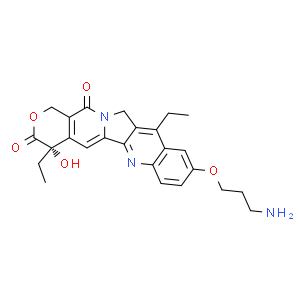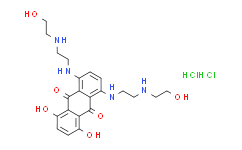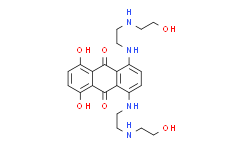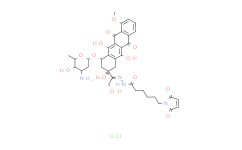| 中文名称: | 安吖啶 | ||||
|---|---|---|---|---|---|
| 英文名称: | Amsacrine | ||||
| 别名: | 安吖啶;胺苯吖啶;N-[4-(9-吖啶基氨基)-3-甲氧基苯基]甲磺酰胺;M-AMSA 溶液;安啶 m-AMSA; acridinyl anisidide | ||||
| CAS No: | 51264-14-3 | 分子式: | C21H19N3O3S | 分子量: | 393.46 |
| CAS No: | 51264-14-3 | ||||
| 分子式: | C21H19N3O3S | ||||
| 分子量: | 393.46 | ||||
| EINEC: | 257-094-3 | ||||
| EINEC: | 257-094-3 | ||||
基本信息
|
产品编号: |
A11327 |
||||
|
产品名称: |
Amsacrine |
||||
|
CAS: |
储存条件 |
粉末 |
-20℃ |
四年 |
|
|
|
|
||||
|
分子式: |
溶于液体 |
-80℃ |
六个月 |
||
|
分子量 |
393.46 |
-20℃ |
一个月 |
||
|
化学名: |
|||||
|
Solubility (25°C): |
|||||
|
体外:
|
DMSO |
10mg/mL (25.4155mM; Need ultrasonic and warming) |
|||
|
Ethanol |
|
||||
|
Water |
|
||||
|
体内(现配现用): |
1.请依序添加每种溶剂:10% DMSO→40% PEG300→5% Tween-80→45% saline Solubility:≥2.5mg/mL(6.35mM);Clear solution |
||||
|
此⽅案可获得≥2.5mg/mL(6.35mM,饱和度未知)的澄清溶液。以1mL⼯作液为例,取100μL25.0mg/mL的澄清DMSO储备液加到400μLPEG300中,混合均匀;向上述体系中加⼊50μLTween-80,混合均匀;然后继续加⼊450μL⽣理盐⽔定容⾄1mL。 |
|||||
|
<1mg/ml表示微溶或不溶。 |
|||||
|
普西唐提供的所有化合物浓度为内部测试所得,实际溶液度可能与公布值有所偏差,属于正常的批间细微差异现象。 |
|||||
|
请根据产品在不同溶剂中的溶解度选择合适的溶剂配制储备液;⼀旦配成溶液,请分装保存,避免反复冻融造成的产品失效。 |
|||||
制备储备液
|
浓度
溶液体积 质量 |
1mg |
5mg |
10mg |
|
1mM |
2.5416mL |
12.7078mL |
25.4155mL |
|
5mM |
0.5083mL |
2.5416mL |
5.0831mL |
|
10mM |
0.2542mL |
1.2708mL |
2.5416mL |
生物活性
|
产品描述 |
是肿瘤细胞 DNA 嵌入剂,还能抑制拓扑异构酶 II。 |
|
靶点 |
Topoisomerase II |
|
|
|
|
体外研究 |
Amsacrine (m-AMSA) blocks HERG currents in HEK 293 cells and Xenopus oocytes in a concentration-dependent manner, with IC50 values of 209.4nm and 2.0μM, respectively. Amsacrine (m-AMSA) causes a negative shift in the voltage dependence of both activation (−7.6 mV) and inactivation (−7.6 mV). HERG current block by amsacrine is not frequency dependent. In vitro studies of normal human lymphocytes with various concentrations of Amsacrine (m-AMSA), show both increased levels of chromosomal aberrations, ranging from 8% to 100%, and increase SCEs, ranging from 1.5 times the normal at the lowest concentration studied (0.005 μg/mL) to 12 times the normal (0.25 μg/mL). Amsacrine (m-AMSA)- induced apoptosis of U937 cells is characterized by caspase-9 and caspase-3 activation, increased intracellular Ca2+ concentration, mitochondrial depolarization, and MCL1 down-regulation. Amsacrine (m-AMSA) induces MCL1 downregulation by decreasing its stability. Further, amsacrine-treated U937 cells show AKT degradation and Ca2+-mediated ERK inactivation |
|
体内研究 |
In animals treated with different doses of amsacrine (0.5-12 mg/kg), the frequencies of micronucleated polychromatic erythrocytes increase significantly after treatment with 9 and 12 mg/kg. Furthermore, the present study demonstrates for the first time that Amsacrine (m-AMSA) has high incidences of clastogenicity and low incidences of aneugenicity whereas nocodazole has high incidences of aneugenicity and low incidences of clastogenicity during mitotic phases in vivo |
推荐实验方法(仅供参考)
|
Animal Administration |
Amsacrine (m-AMSA) is investigated in three separated experiments. In the first experiment, animals are treated by intraperitoneal injection with 0.5, 1.5 and 4.5 mg/kg of amsacrine and bone marrow is sampled 24 h after treatment. Preliminary negative MN results at this sampling time lead to the use of 30 h sampling time for amsacrine. Thus, in the second experiment, mice are treated with 0.5, 1.5 and 4.5 mg/kg of Amsacrine (m-AMSA) and bone marrow is sampled 30 h after treatment. The doses and sampling times for amsacrine are chosen by reference to earlier studies and the selected doses are within the dose range used for human chemotherapy. The results again show that the micronuclei frequency in the bone marrow of mice is not affected by treatment with any of the selected doses of the test agent, at 30 h sampling time, thus, in the third experiment, mice are treated with 6, 9 and 12 mg/kg of amsacrine and bone marrow is sampled 24 and 30 h after treatment. |
本计算器可帮助您计算出特定溶液中溶质的质量、溶液浓度和体积之间的关系,公式为:
质量 (g) = 浓度 (mol/L) x 体积 (L) x 分子量 (g/mol)
摩尔浓度计算公式
用本工具协助配置特定浓度的溶液,使用的计算公式为:
开始浓度 x 开始体积 = 最终浓度 x 最终体积
稀释公式
稀释公式一般简略地表示为:C1V1 = C2V2 ( 输入 输出 )












